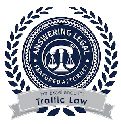Explanation of the Traffic Summons
You’re driving along, going with the flow of traffic, and listening to your music when all of a sudden, it happens—multi-colored lights flood your car. A siren wails. You are being pulled over. The rest of the experience is like a blur. All you remember is “license and registration… do you know why I stopped you… do you know what the speed limit is… do you know how fast you were going…” The cop leaves and comes back a short time later. He returns you your license and a summons. You faintly recall what he said. Something about a “return date” and that you could enter a “plea.” You are left with a piece of paper (or two or three), and when you finally sit down to read it, it’s so confusing it may as well be written in a foreign language.
If this is how you feel, calm down. This page is designed to explain to you step by step what your ticket means and what you have to do to answer it so, at a minimum, you do not end up with a license suspension.


Also note that a computer-generated ticket can be written in the City of New York, and that a handwritten ticket can be written outside of those places. Other than slight differences in language between the tickets as it pertains to the method for mailing the ticket in with a plea, the content of these 2 tickets are identical.
In addition, you may have also been issued a document that looks like the one below. This is called a “supporting deposition,” and, for purposes of understanding your ticket and the charges, it is not relevant. However, do not discard it and give it to the lawyer that you retain because a lawyer can use it to prepare for trial or as leverage to have a case dismissed.
Also note that a computer-generated ticket can be written in the City of New York, Rochester, or Buffalo and that a handwritten ticket can be written outside of those places. Other than slight differences in language between the tickets as it pertains to the method for mailing the ticket in with a plea, the content of these 2 tickets are identical.

These are the ONLY TWO TICKETS NY State Police Agencies use for vehicle and traffic violations. IF YOU WERE GIVEN A TICKET THAT DOES NOT LOOK LIKE EITHER OF THESE TICKETS, IT IS NOT A TRAFFIC TICKET! Nonetheless, our office can still help you, and it would be best if you faxed both the front and back of the ticket to us at (914) 777-2990 for further assistance and a free phone consultation.
A traffic ticket in New York is formally known as a Uniformed Traffic Ticket, or “UTT.” It can be used to charge a motorist with a traffic infraction, a traffic misdemeanor such as reckless driving or DWI, or a traffic felony such as DWI. The following is a breakdown of the sections of the ticket with corresponding explanations.

The upper left of the ticket simply describes you, your address, driver’s license state and identification number, and the year, make, model, and plate number of the vehicle you were operating.
This section of the ticket identifies what you have been charged with (i.e., “speeding” or some other violation). The uppermost row contains the date and time of the stop, along with the name of the NY State Law that is alleged to have been violated (it will be either the “V and T Law” or the Transportation Law, noted on the ticket as “Trans. Law”).


Under the upper row of boxes is the section of the law that was alleged to have been broken. In this example, it’s “1180D.” To the right of that row is a check box for either a traffic infraction (“Tr. Inf”), a traffic misdemeanor (“Misd”), or a felony. Also along that row are boxes for a speeding charge, the alleged speeding rate, and the speed limit on the roadway. Below that is an area where the arresting officer can write descriptive notes as well as complete information about a truck if the vehicle stopped was a commercial vehicle.
The rest of the middle section gives the boxes to indicate the street the stop occurred on, the name of the city where the stop occurred, in which county the stop occurred, a place for the officer’s signature, and the officer’s name printed beneath the signature.
The bottom left of the ticket contains the absolutely essential information you need in order to timely answer this summons so that your license does not get suspended. This section tells you the full name and address of the court and the return date. Depending on which box is checked off, you (or your attorney) will either have to appear in person on the appointed date and time or mail the ticket in with a “Not Guilty” plea by the deadline date and time.
A lot of bad things happen when you do not timely enter your plea by mail or appear in court on the appointed date. Some courts send out warning letters, but many immediately suspend your license. In the event that the charge was a misdemeanor or felony, a warrant is also issued for your arrest. Many courts also make you post a bond to get a new date. If you have blown a plea date, our office can often have the suspension lifted, the bond waived, and the warrant recalled without the need for you to go to court.

This section also explains to you, in all capital letters, that pleading guilty by mail is the same as being found guilty after a full trial. What it is explaining is that it makes no sense to plead guilty “as charged,” and your case can only get better if you plead “Not Guilty” and fight the charges. It also explains that a plea of guilty may trigger a suspension, revocation from the DMV as well as an additional fine, i.e., the driver responsibility assessment). These eventualities are in no way preventable or controllable by the court and trigger under the administrative regulations of the NYS DMV.
If you received your ticket in New York City, Rochester, or Buffalo, the text on this portion of the ticket is slightly different, reflecting the procedure for mailing the ticket to the court with a plea is slightly different. On the ticket, it advises that you have 15 days from the date of the offense to mail it to the court. However, that is misleading. The return date for an NYC, Rochester, or Buffalo is actually 75 days from the date of the stop, i.e., 60 days from the 15th day after the offense.
This section tells you how to enter a plea by mail and warns against pleading guilty to a 3rd speeding ticket, as that will cause a license revocation.

However, for tickets written in NYC, Rochester, and Buffalo, the instructions indicate that they go to a centralized infraction bureau at the NYC DMV for entry of a plea. The address is Traffic Violations Plea Unit, PO Box 2950-ESP, Albany, NY 12220-0950.

Our office highly recommends that you do not plead guilty “as charged” without availing yourself of a free phone consultation from us. In addition, if you do plead guilty “as charged,” save your ink and don’t bother writing any statement of explanation. It matters not what your excuse is. Pleading guilty as charged triggers the entirety of the punitive regulatory scheme against you.
This is the section you complete if you are pleading “Not Guilty.” Although it says that you must mail it in with such a plea within 48 hours, this is NOT TRUE. You have until the return date indicated on the lower left portion of the ticket to return the ticket with the plea to the court. Why it states 48 hours to return the ticket with a plea of “Not Guilty” is a mystery, but it is very misleading.

Our law office offers convenience, ease, and certitude of a positive outcome. We will represent you in any court in the State of New York. We get your court appearance waived, so you do not have to take time off. We give you peace of mind by giving you a money-back guarantee.
Call us toll-free at (877) 99-NO-TIX (1-877-996-6849) or email. We need your name, the name of the court, the charge(s), and if you have a speeding ticket, the speed limit, and the speed charged. You can email us, scan and email the ticket, or fax it to us at (914) 777-2999. Don’t wait, do it today!




Advance Legal
Medicaid Fraud Attorney
Estate Lawyer NY
Advance Legal Blogspot
Brooklyn Trust and Will
